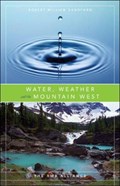Narrow Results By
A..."climate"...ising to Alberta in the dawn of the Anthropocene
https://archives.whyte.org/en/permalink/catalogue20009
- Medium
- Library - Periodical
- Author
- Skrajny, Joanna
- Publisher
- The Alberta Wilderness Association Journal
- Call Number
- P
1 website
- Author
- Skrajny, Joanna
- Responsibility
- Joanna Skrajny
- Publisher
- The Alberta Wilderness Association Journal
- Physical Description
- p. 22 - 25
- Medium
- Library - Periodical
- Abstract
- Pertains to climate change during Anthropocene including increased wildfires, ticks, and tick-borne diseases, floods, increase in insurance rates, and negative effects on health and mental health, wildlife extinction, decrease in fresh water.
- Notes
- In Wildlands Advocate, Vol. 27, No.2, June 2019, p. 22 - 25
- Call Number
- P
- Collection
- Archives Library
- URL Notes
- Digital version of publication available online
Websites
This material is presented as originally created; it may contain outdated cultural descriptions and
potentially offensive content.
Read more.
An impending water crisis in Canada's western prairie provinces
https://archives.whyte.org/en/permalink/catalogue24934
- Medium
- Library - Book (including soft-cover and pamphlets)
- Published Date
- 2006
- Author
- Schindler, D.W.
- Donahue, W.F.
- Publisher
- Proceedings of the National Academy of Sciences of the United States of America
- Call Number
- 03.5 Sc1a PAM
1 website
- Author
- Schindler, D.W.
- Donahue, W.F.
- Responsibility
- D.W. Schindler
- W.F. Donahue
- Publisher
- Proceedings of the National Academy of Sciences of the United States of America
- Published Date
- 2006
- Physical Description
- 6 pages ; illustrations , maps
- Abstract
- Canada is usually considered to be a country with abundant freshwater, but in its western prairie provinces (WPP), an area 1/5 the size of Europe, freshwater is scarce. European settlement of the WPP did not begin until the late 19th and early 20th centuries. Fortuitously, the period since European settlement appears to have been the wettest century of the past two millennia. The frequent, long periods of drought that characterized earlier centuries of the past two millennia were largely absent in the 20th century. Here, we show that climate warming and human modifications to catchments have already significantly reduced the flows of major rivers of the WPP during the summer months, when human demand and in-stream flow needs are greatest. We predict that in the near future climate warming, via its effects on glaciers, snowpacks, and evaporation, will combine with cyclic drought and rapidly increasing human activity in the WPP to cause a crisis in water quantity and quality with far-reaching implications.
- Notes
- In PNAS May 9, 2006 103 (19) 7210-7216
- Call Number
- 03.5 Sc1a PAM
- Collection
- Archives Library
- URL Notes
- Available online via PNAS's website
Websites
This material is presented as originally created; it may contain outdated cultural descriptions and
potentially offensive content.
Read more.
Water, weather and the mountain west
https://archives.whyte.org/en/permalink/catalogue13641
- Medium
- Library - Book (including soft-cover and pamphlets)
- Published Date
- 2007
- Author
- Sandford, Robert W
- Publisher
- Surrey, B.C. : Rocky Mountain Books
- Call Number
- 03.5 Sa5wa c.1
- 03.5 Sa5wa c.2
- 03.5 Sa5wa ref. c.3
1 website
- Author
- Sandford, Robert W
- Publisher
- Surrey, B.C. : Rocky Mountain Books
- Published Date
- 2007
- Physical Description
- 207 pages : illustrations
- Subjects
- Conservation
- Water
- Watersheds
- Canada
- Climate
- Climate change
- Climatology
- Hydrology
- Hydrology - Alberta
- Abstract
- Growing populations, increasing industrial use and heavy agricultural demand are beginning to tax water supplies in many regions of Canada. Since many rivers are already fully allocated to numerous uses, future economic and social development will depend upon how much we know about our surface and ground water resources and how effectively we manage them—especially in the face of climate change. The message to take home from this eloquent book is that it is time to dispel the myth of limitless abundance of water in Canada and throughout North America. We all need to be mindful that though our technologically sophisticated society is largely fuelled and lubricated by refined petroleum, it ultimately runs on plain water. In his conclusion to this authoritative book, Robert Sandford, chair of Canada’s United Nations Water for Life Decade, offers a realistic picture of the various issues and threats related to the future availability and quality of fresh water in Canada. (from Rocky Mountain Books website)
- Contents
- Invocation: through mist and rainbow the water speaks
- One: water, weather and the west
- Two: the drinking-water supply in Canada
- Three: what can we learn from others
- Four: reading the wind: reframing the climage-change debate
- Five: future landscapes in the mountain west
- Appendix One
- Appendix Two
- Written on the wind: a climate-change bookshelf
- Index
- Acknowledgements
- Notes
- Includes bibliographical references (p. 196-198) and index
- ISBN
- 9781894765930
- Accession Number
- 40500 - 2 copies
- P2020-2
- Call Number
- 03.5 Sa5wa c.1
- 03.5 Sa5wa c.2
- 03.5 Sa5wa ref. c.3
- Collection
- Archives Library
- URL Notes
- Summary on Rocky Mountain Books website
Websites
This material is presented as originally created; it may contain outdated cultural descriptions and
potentially offensive content.
Read more.

